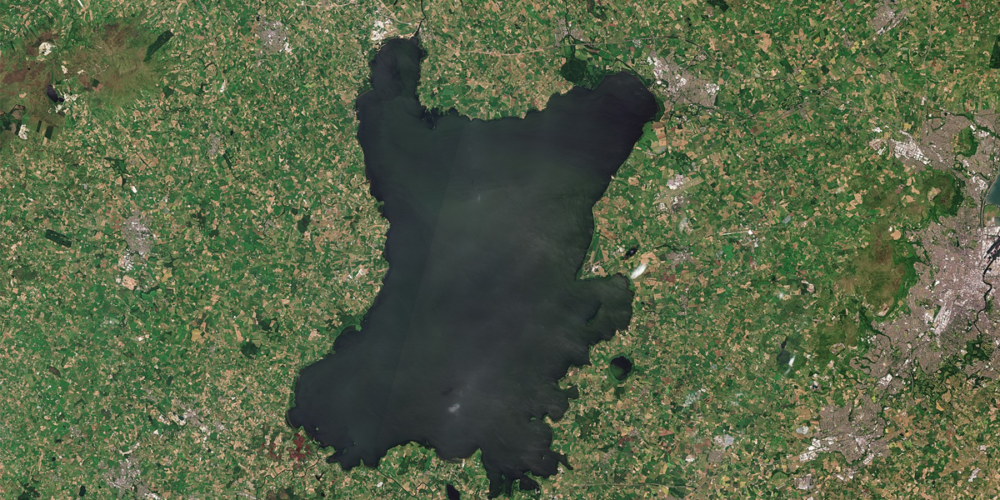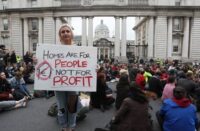Lough Neagh, just outside Belfast, has often been described as the “eye of the bear” that is the outline shape of the island of Ireland. It is the largest fresh-water lake in Ireland or England. The lake is 20 miles long, about 10 miles wide and is about the size of Malta. It is the source of 40% of the North’s drinking water. Lough Neagh has also supported a large fishing industry, including an eel fishing cooperative. Sand is dredged illegally from the bed of the lake. For generations, tourists and local people have enjoyed the pleasures of walking, swimming, and many other activities around this lake. Abundant wildlife is a strong feature of this area.
All that started to change in the early Spring of 2023 when the Blue-Green Algae was discovered in the lake. It is a toxic algae that killed pets and wildlife in the area. It was a great media story, portrayed almost like it was something from a horror movie, which in fact it is, but sadly also a further sign of the destruction of nature and our climate. The same toxic blue-green algae has been recorded in many other lakes and waterways throughout Ireland.
None of this is new, unknown or come as any surprise. In 2013, a Queens University study of the lake and its surrounding wetlands, showed that winter migratory birds had dropped by 80%. And a loss of 66% of insect and snail species from the lakebed. The temperature of the water has risen by one degree centigrade since 1995. They also say that the presence of the invasive species of Zebra mussels, in epidemic proportions, leaves the water unnaturally clear, by their feeding actions, allowing sunlight to penetrate deeper into the water and exacerbating the blue-green algae phenomenon. Friends of The Earth in the North have described the lake as “dying in plain sight”and openly state that the lake has been “ignored, forgotten and abused for decades [and] is the story of wild west exploitation.”
All this despite the fact that up to two dozen organisations from government departments, councils and charities are, supposedly, looking after the condition of the lake. But it is clear now, that all laws, regulations, and reports are clearly being ignored. That local people, and especially the fishermen, have pointed to the ongoing destruction of the lake for decades, has also fallen on deaf ears. The “elephant in the room” is why? So, who does this “blind eye” approach benefit? And what are the major causes of the lake’s destruction?
As always, profit and greed are the ultimate cause of climate destruction and the “killing” of our lakes and wetlands. The central cause that has been identified in the case of Lough Neagh, is agricultural fertilizer and chemical run-off into the six main rivers, via multiple networks of streams, that feed the lake. Poor wastewater treatment is another identified polluting source. There has not been a lot of talk about factory or quarrying waste discharge in this industrialised area, which is odd to say the least. The shores of the lake touch five counties of the North, so there is clearly more to this than the much maligned “poor farmer”.
In Ireland and right across Europe we have witnessed farmers protesting to improve the prices they get for their produce. The advent of “factory farming” was hailed as the “profit basket” par excellence. However, true to capitalist form, that was to be the inevitable “race to the bottom”, especially for the farmer and, as a consequence, our climate, waterways and wildlife. Farmers’ prices are controlled by the beef barons, the multinational milk and food companies and the supermarket chains. The farmers are forced to dance to their pricing tunes or die, like Lough Neagh. To survive the demands of the market, farmers must continually find ways to reduce their costs but also produce more as well, to compensate for the ever-increasing squeeze on their produce prices.
To earn a living, the land must be chemically forced to produce more. That means new types of high-yield and wholly unnatural grasses. These grasses are not suitable areas for insects, bees and ultimately, birds. What was once mixed vegetation agricultural land is now a dark green, monocultured wildlife wasteland. Ever increasing dowsing is necessary by way of chemicals, fertilizers, and the ubiquitous animal slurry to force grass and crops to grow faster or in a more prolific way. When the rains fall, all of the residue of this “crop forcing” is washed into our waterways. This is ultimately because the capitalist market has forced the farmers to induce their animals and crops to produce more in order to ensure their slice of an ever-dwindling pie. More recent farmer diversification into fully housed cattle, pig and fowl production is further increasing waste effluent and chemicalised, unnatural food at the end of it all. All in the quest for more profits and greed of the financial institutions, the seed producers, the chemical and fertilizer companies, the machinery companies, the beef barons, the multinational food and milk producers and the multinational supermarket chains.
All of their profits come first, way in front of the farmers, workers or the health of the nation and this ultimately leading to the destruction of our climate. The blue-green algae on Lough Neagh is but a symptom, a clear “eye” of the storm of the ever-growing destruction of our world by capitalism.






